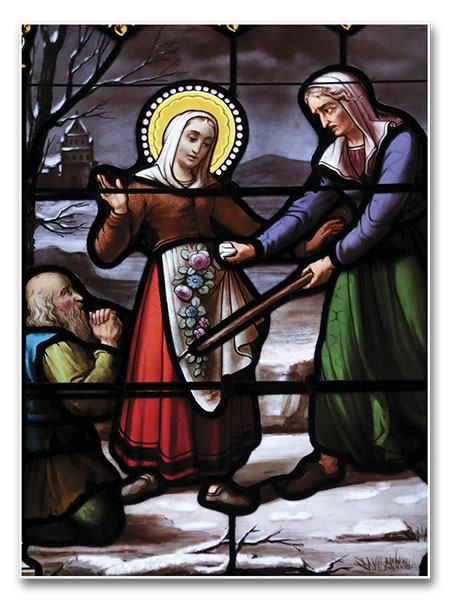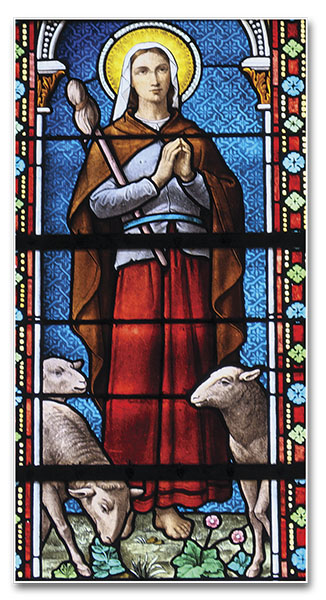The perfectly intact body decades after death, the continuous miracles and the fervent devotion of the faithful demonstrated the zeal of the Most High in defending a cause that was His alone!

T he tall, slender windows, large towers and half-walled façade lent a fortress-like appearance to the small medieval church of St. Mary Magdalene in the French village of Pibrac.
The village was no more than a few kilometres from the large, developed city of Toulouse, which dominated the south of France and had acquired great fame over the centuries. Among the innumerable feats recorded in its history was the departure for the First Crusade of its count, the ambitious Raymond IV; it had witnessed the countless blows struck in its vicinity by the sword of Simon of Montfort in the fight against the Cathar heresy; and more recently it had also been the scene of bloody battles between the Catholics and the Protestant Huguenots.
However, these episodes – among many others – had little effect on the simple, country life of the inhabitants of Pibrac. They were completely absorbed with the care of their livestock, how the weather conditions affected the plantations and, at times, the outbreak of war. A dignified and pious existence based on honest work was all they longed for. Until one afternoon in 1644, an event changed the routine of the village and later made it known to the farthest corners of the Catholic world.
An extraordinary discovery
Guillaume Cassé is toiling with all his might to remove a thick stone slab from the floor of the church in Pibrac. A pious parishioner has died, and her relatives want to lay the body to rest within the sacred enclosure, there to await the final resurrection. After numerous blows and a great deal of effort, the gravedigger once again wields the pickaxe, penetrating deeply and detaching the stone.
Suddenly, he gives a shout of amazement, drawing everyone who hears it running to the spot. Peering into the opening, they behold a sight that is both prodigious and startling: the body of a maiden lying there in perfect condition. She seems so alive that everyone notices the red mark left on her face by Guillaume’s pickaxe. What a miracle!
The news soon spreads through the village and the people flock to the church to see for themselves. Who was this Saint born in their midst, but whose virtue had gone unnoticed? Finally, some of the older and more knowledgeable villagers recognize her: it is Germaine Cousin, the poor, scrofulous shepherdess who had died over forty years earlier.
Even without knowing much about how she had lived or what she had done, the people lifted her out of the tomb and began to venerate her in a lateral area of the church. They had not the slightest doubt that such peace, serenity and joy could only emanate from a body whose soul was very close to God and the Blessed Virgin.
But, after all, who was this captivating and yet unknown young woman?
Contemplation amid suffering
History does not reliably record the name of Germaine’s parents, but it is known that she belonged to the Cousin family, owners of a farm in Pibrac.
In addition to an atrophied right arm, which was noticeably deformed on her angelic body, Germaine suffered from a terrible disease, scrofula. In those days, this malady was incurable; since it was also contagious, the girl’s physical sufferings were accompanied by the contempt and inhumane treatment of her stepmother.
Among the humiliations the latter inflicted on her was the prohibition of her ever coming near the family table and being forced to sleep in a corner of the corridor or even in the stable, from where she had to leave early in the morning to spend the day in the fields tending the flock. This was the only job for which she was judged capable, besides which it served to keep her away from the house. Whether it was winter or summer, she always wore the same clothes, and was given only a piece of bread to eat.
All day long, Germaine led the flock through the forest of Bouconne or the meadows near the village, taking care that no sheep strayed or was attacked by wolves. Whoever met her at those moments could have no idea how much she suffered. Always cheerful, noble and generous, the little shepherdess did not spend her hours of solitude dwelling upon the sorrows and difficulties of life. Separated from the agitation of the world, from the ebullience of the passions and from human ambitions, she took the opportunity to contemplate the marvels of creation that so well reflected God and His Mother, to whom the young girl devoted special affection.
However, not infrequently the days ended in beatings and punishments from her stepmother, who vented her bad temper on the innocent girl.

She never missed an opportunity to be with Jesus and Mary
If the inhabitants of Pibrac saw little of Germaine and knew almost nothing of her duties, there was one place they were sure to find her daily: the parish church. When she heard the bells calling the faithful to God, she would entrust the flock to some acquaintance – and when she could not find anyone to help her, she would leave the sheep to her heavenly companions – and head straight for the celebration of the Eucharist.
Even without a formal education, she discerned the infinite value of the Blessed Sacrament, and she would let nothing replace that hour of intimacy with her Divine Model, present there Body, Blood, Soul and Divinity. And she rejoiced to be able to receive Him on all the feast days.
The hour of the Angelus, which sounded in the belfry, was also sacred in the routine of the little shepherdess. Wherever she was, she would interrupt whatever she was doing, get down on her knees and recite the prayer, venerating the supreme moment when Mary said “yes” and the plan of God was fulfilled in history. She did not even hesitate, on one occasion, to drop to her knees in the middle of the river when she heard the bell ringing as she crossed it, or to soil herself in the mud because she was passing through a marshy place.
Another strong element of Germaine’s piety was the recitation of the Rosary, through which she grew in intimacy with Her who is God’s Paradise. From this union she drew the strength to face her difficult life with courage, confidence and a supernatural spirit, and to make of it an instrument of combat for God himself.
If, by opening a door handle, the Blessed Virgin gave more glory to God than a martyr in his torments, how much could the illnesses, labours, isolation and ill-treatment that Germaine suffered be worth, united to the merits of Mary?
This was the reason for the constant serenity and joy that the young girl communicated, bringing her self-forgetfulness to the point of heroism. On one occasion, noticing her even weaker and more wasted than usual, they learned that that week she had deprived herself of her sole piece of bread, giving it to a poor man, famished with hunger, whom she had met on the road.
The current calmed
Although the people of Pibrac paid her no heed, her family despised her, and no one recognized her virtues, there is no doubt that many people felt deep in their soul that this little shepherd girl represented something superior, more of Heaven than earth. There was no lack of witnesses to this effect in her canonization process, and there are even accounts of miraculous events that occurred with the little girl.
For example, on one occasion she approached the Courbet River, which she always crossed to get to church. However, on that day the rain had been heavy and the current was strong. Without hesitating, Germaine advanced towards the water, which subsided and allowed her to pass in peace.
There were also those who attested to a miracle similar to the one that occurred with St. Elizabeth of Hungary: in the middle of winter, Germaine left home carrying leftovers of bread for the poor, hidden in her apron. Perceiving the quantity that the young girl was carrying, her furious stepmother ran after her and forcibly opened the apron, causing a great profusion of flowers to fall to the ground…

Unnoticed to the eyes of men, but precious before God
In suffering and oblivion, with her health growing weaker and weaker, the shepherdess reached the age of twenty-two.
One morning, probably in the year 1601, the flock did not go out to pasture. What had happened? They entered the stable and saw that Germaine’s soul had ascended into eternity as serenely as she had lived; only her body remained lying among the sheep. And by them alone would it have been venerated, if the Most High had not deigned to reveal to history the greatness of that soul hidden from human eyes, “but in God’s sight chosen and precious” (1 Pt 2:4).
Not a single word from Germaine’s lips was ever recorded, but she taught the whole world how true worth, glory and success are those obtained before God. Her intact body, the countless miracles and the constant devotion of the faithful demonstrate the zeal of the Most High in defending a cause that was His alone!
In a century beset by the errors of pseudo-reformers and constant wars against the Holy Church, Germaine’s existence may well be considered reparation to the Divine Heart. Her faith in the Real Presence in the Eucharist and her ardent devotion to Mary reinforced the points most under attack from heretics; her unconditional submission and self-abasement stood in opposition to the rebellion against papal authority.
Watering these virtues with the continuous offering of her sufferings, Germaine not only presented atonement to God for human offences, but also attenuated the evils that these same outrages brought upon the world.
A long wait for glorification
After the discovery of Germaine’s body, Fr. Sounilhac, the parish priest of the Church of St. Mary Magdalene in Pibrac, ordered it to be placed in a simple sarcophagus and left in the side nave of the church, as the people were inseparable from the one they already considered their Saint. But soon the miracles began and Germaine’s fame spread beyond the confines of the town…
Fearful of transgressing the prohibition of Rome to render official cult to a deceased person before ecclesiastical approval, the parish priest transferred the body to the sacristy. However, he continued to receive the thousands of pilgrims and to carefully record the miracles obtained, before a notary.
However, the authorities did not share the same haste and enthusiasm as Germaine’s devotees in promoting her glorification.
Only in 1661 did Canon Dufour, Vicar General of the Archdiocese of Toulouse, make his way to Pibrac in order to learn more about this supernatural reality. He opened the coffin and immediately verified the miracle; he had the stone under which Germaine had been originally buried lifted to check the properties of the soil; and of the dead parishioner who had taken her place, he found only dust…
There could not be the slightest doubt: this incorrupt body was the work of God. He sealed the sepulchre with thick padlocks, had it placed out of the reach of the faithful and took his leave, recalling the norms of Rome and promising to set up a commission to prepare the diocesan process for canonization.
In 1680 the Commanders of the Order of Malta, under whose care that church had been placed, were desirous of seeing the miracle. Amazed, they certified that the shepherd girl’s body was “whole, still appearing to be of flesh, with flexibility in all its members when held and moved.” 1

At long last, the canonization!
In the meantime, thirty-five years had passed since the Vicar’s visit, and there had been no news from him… The people, receiving ever-increasing favours from the holy shepherdess, did not give up. They sent the mayor of Pibrac, Jacques de Lespinasse, to ask Archbishop Colbert of Toulouse to do something for the recognition of Germaine Cousin’s glory.
After some years of delay, the prelate acceded and commissioned Fr. Morel to begin the process. In 1700, with a solemn Mass attended by a crowd of devotees, the priest opened the sepulchre again and contemplated the miracle. He then listened to the numerous accounts of miracles obtained through the humble shepherdess, heard the opinions of doctors and experts and, finally, also heard the testimony of Françoise Pères, a seventy-seven-year-old woman who, as a girl, had witnessed the discovery of the body and heard the accounts of those who had known Germaine and had attested to the holiness of her life.
With everything archived, Fr. Morel sent the dossier to Rome through a Capuchin priest. Decades passed and no answer was received… What had happened? Only much later did it become known that the material was lost and never reached its destination. Many more battles had to be fought before Gregory XVI resumed the process in the 19th century and Pius IX concluded it with the solemn canonization in 1867.
Example for our days
In the long period before the Saint’s earthly glorification, God did not tire of revealing to the world, through ceaseless miracles, the valour of her generous and self-sacrificing soul. And the wicked understood this well. When the French Revolution exploded, the Comité de Salut Publique ordered this virginal and luminous body be cast into a pit of lime.
Why did the Revolution, which called itself the defender of the rights of the people, not make an idol of that poor, sick and excluded shepherdess? Because, first of all, Germaine had fought and won in a much more sublime field than that of social issues: before the Heart of God!
It is in this sense that Dr. Plinio Corrêa de Oliveira comments on her, proposing her as a model for us: “The Catholic of our days must be proud, combative, aware of his importance, not forgetting, however, to represent before his age, the virtues of St. Germaine Cousin. Often rejected, frowned upon, isolated and persecuted, he sees the most unjustified enmities forming around him, while the most solid friendships crumble. He has to fight openly against the powers of his time, rowing against the rising tide of the vices and deviations of his era. Not infrequently he becomes the object of contempt, if not hatred. […] Nevertheless, when God’s glory is touched, we must defend it like lions. And in matters that concern only self-love or personal claims, we must be as meek as lambs. Then we will have imitated in our own way the virtues of St. Germaine, both bowing our heads in the face of humiliations and defending God’s glory like warriors.” 2
Thus we can conclude how timely, even for our troubled 21st century, is the exclamation from the lips of Pope Gregory XVI when he saw the documents for the beatification of the shepherdess of Pibrac: “This is the Saint we needed.” 3 ◊
Notes
1 RICHOMME, Agnès. Sainte Germaine de Pibrac. Paris: Fleurus, 1967, [n.p.]
2 CORRÊA DE OLIVEIRA, Plinio. St. Germaine Cousin. In: Dr. Plinio. São Paulo. Year XIII. N.147. (June, 2010); p.14-15.
3 VEUILLOT, Louis. Sainte Germaine Cousin. 3.ed. Paris: Victor Lecoffre, 1904, p.173.








Thank you for this beautiful article on St Germaine Cousin.